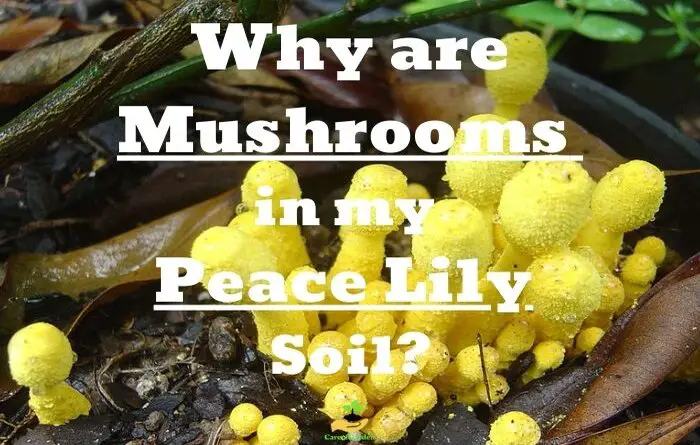Why are Mushrooms in my Peace Lily Soil? (Quick Answer)
If you’ve ever found small mushrooms in the soil at the base of your Peace Lily, you’re not alone. Let’s find out why there are mushrooms in my Peace Lily soil!
The appearance of mushrooms in the Peace Lily soil is caused by improper care factors like: waterlogged soil, unsuitable temperature conditions, and excessive fertilization, which activates the growth of fungal microflora.
With this we do not mean that you do not know how to take care of your Lily plants, but rather that each plant requires very specific care at different times in its life!
Why are mushrooms growing in my peace lily?
The small mushrooms that you see in your Peace Lily’s soil are called yellow lepiota (Leucocoprinus birnbaumii). They are small mushrooms from 3 to 5 cm, pale yellow, flaky, with a spherical or flat cap.
Recognizing them is really easy: small white or yellow heads will sprout from the ground soil.
1. Waterlogged soil
Waterlogged soil is the first cause why mushrooms appear in Peace Lily, because this moist and warm environment causes mold to form and rot, which promotes fungal growth. This causes fungal spores to grow and germinate, forming new mushrooms or fruiting bodies that look like they would have grown in the wild.
Fungi often pop up for certain conditions, one of which is that the plant has too much moisture. This humidity can be relative both to the environment surrounding the plant and to too abundant watering.
The more you water, the more you impoverish the soil. As a result, mushrooms have a malicious pleasure in developing.
If the environment in which the plant lives is very humid, it is easy for mushrooms to grow in the soil. Just as the first thing you need to check when you notice this phenomenon is the soil moisture .
If you water your plant abundantly, the ecological balance is disturbed, which often entails favorable conditions for some and unfavorable conditions for other bacteria, then moldy soil areas begin to appear and spores of all these fungi wake up.
Stop watering for a few days and let the soil dry out a little, even better if you move your plant to the sun: the mushrooms will dry out in no time.
Mushrooms in a Peace Lily pot are not terrible if the flower is not waterlogged. They appeared because there is a lot of undecomposed organic matter in the soil and it was not subjected to sterilization.
Fungi thrive in humid climates, so frequent rainfall and the formation of puddles or stagnant water are ideal for their growth.
2. Overfertilization
The second reason why mushrooms appear in Peace Lily is because the soil is rich in organic substances. For example, if we have just fertilized with compost or with organic substances, we have created the perfect environment for mushrooms.
After all, as gardeners we should be aware that our gardens are small ecosystems and any change in one component can have a direct effect on the rest.
For example, when we apply fertilizers excessively to ensure the growth of our plants, what we achieve in most cases is just the opposite effect: the appearance of fungi. This is due to the high levels of organic waste present in fertilizers.
Mushroom’s can be found in nature wherever organic material decomposes. This is also the case in the Peace Lily soil, where the mushrooms find good conditions to thrive.
Mushrooms feel particularly comfortable in humus-rich soil. Even soil with a high peat content offers fungi numerous organic substances that they can decompose
Mushrooms, as I said above, feed on decomposed organic substances. So if you have fertilized with compost or with fertilizers derived from kitchen waste, it is likely that these have fueled the appearance of mushrooms .
In particular, they absorb nutrients from plants, for example from leaves that rot in the ground. So they absorb the nutrients available in their environment, which in your case is the pot of the plant.
3. Temperature imbalance
Thirdly, mushrooms appear in Peace Lily’s when the temperature of the soil is too high. Warm and moist soils are favorable for mushrooms because they are soft and easy for them to grow on them.
For mushrooms to appear in the soil in needs temperatures that are between 50-68 degrees Fahrenheit.
High temperature also cause the appearance of mushrooms in the soil because mushrooms thrive in warm and humid environments. If you’re looking for mushrooms in your yard or garden, then look for them near trees and other vegetation as this is where they often grow.
You may see the mushroom above ground or just its cap because it often grows under the soil. The mushroom is thin and flat, with a brownish-yellow coloration. It may have a white or pinkish tint when it’s young, but as it matures it will turn dark brown to black.
It’s important to note that the temperature of the soil can be different from the temperature of the air. For example, if it’s a warm day but the soil is cool, then mushrooms may appear in your pot or garden.
Do your Peace Lily’s leave have holes in them? Find out in this article the reasons why!
Are Mushrooms in my Peace Lily soil harmful?
The answer is no. You can completely let the mushrooms live their life in your Peace Lily soil (even if it is recommended to remove them). However, if these mushrooms are harmless to the health of your plants, they are not edible (neither for you nor for your four-legged friends).
This type of fungus won’t harm your houseplant, but they are thought to be poisonous. Most fungi have a symbiotic relationship with plants, especially at the root level.
Fungi help plants get the nutrients they need to produce the sugar they feed on, so they help each other grow and get the best nutrients they can get.
These fungi are not dangerous for your plant, nor for the air in your interior. You can leave them without fear.
You can also handle them without problem, with gloves if necessary. Be careful, these mushrooms are not edible , and therefore can be toxic!
Fungal spores cause allergies in some people and pets. Molds like to settle on mushroom caps, which are poisonous and dangerous to humans.
Therefore, it is better to remove mushrooms from the Peace Lily soil.
So be careful! If you want to tear them off, protect yourself with gloves.
How to prevent mushroom’s growing in Peace Lily
Fungi in Peace Lily soil cannot be completely prevented. However, if the following rules are maintained, mushroom formation in Peace Lily’s soil can be avoided:
- Avoid waterlogging by creating a drainage made of expanded clay or potsherds.
- Make sure the drainage hole in the pot is free.
- Avoid high humidity in the room (with indoor plants).
- Remove decomposed material (such as dead leaves) from the soil surface.
- Water only when the top layer of soil has dried out. If possible, water the plant from below.
- Always use good quality soil when planting.
- Don’t use garden compost for houseplants unless you can sterilize it. It is not only ideal for growing mushrooms, but it is also unknown what else lives in it.
- Mushrooms thrive in warm and humid conditions. So put the plant for a while in a cool, dry place.
How to Remove Mushrooms growing in my Peace Lily
To remove mushrooms (Leucocoprinus birnbaumii) from Peace Lily soil, the easiest way is to repot, remembering to protect your hands.
Get a pair of gloves and carefully remove the infected area, being careful not to spread the infection further. Get rid of the bad soil and gently wash the root of the Peace Lily under running lukewarm water.
If the roots show that they are diseased, prune the diseased parts. Then put the new soil in the new container and transplant your Peace Lily. After, water it and make sure all the other growing conditions are right, so it can thrive, fungus-free houseplants!
Once this step has been completed, add natural fertilizer to your soil to provide the plant with all the nutrients it needs to grow and protect itself from parasites.
Then choose a more or less sunny location depending on the needs of the species. And of course, be vigilant in watering your plants.
Where do the mushrooms come from?
The spores that cause fungal growth in houseplant soil are usually introduced through a contaminated potting mix. But sometimes they can be introduced by other means, such as air traffic or clothing spores.
There are several reasons why mushrooms ended up in the soil:
- The spores were already present in the soil
This is the most likely explanation for the fungi in the soil. Mushroom spores flew somewhere near the plant, and some fell into the soil.
It could have happened anywhere in the supply chain: at soil production, at the nursery where the plant was grown, at the time of delivery, or at the garden center where you bought the plant.
- Soil mixture is too nutritious
Mushrooms grow well in fertile soil, so spores can germinate easily.
Mushrooms do not grow like plants. In order to reproduce, their spores need to attach themselves to a food source, whether it be the roots of a plant or a dead or living plant.
They don’t use seeds like most other plants, but as long as there is wind or some way to carry the spores to a nutrient source, that’s all they need to reproduce.
Fungi always grow where decomposition processes of organic material take place. They are found on soils that have a high humus content.
This is often the case even with simple potting soil if there is too much peat or peat substitutes. Humidity, the amount of water in the soil and the room temperature also play a role.
The fungi release their spores into the air and can therefore trigger allergic reactions in sensitive people. Sometimes yellow mushrooms also grow in the flowerpot. This is usually the yellow folding umbrella. Since there are still no sufficient studies on its toxicity, the fungus should be removed in any case if children are in the house. Since the mushroom looks interesting, curious children might get the idea to snack on it.




